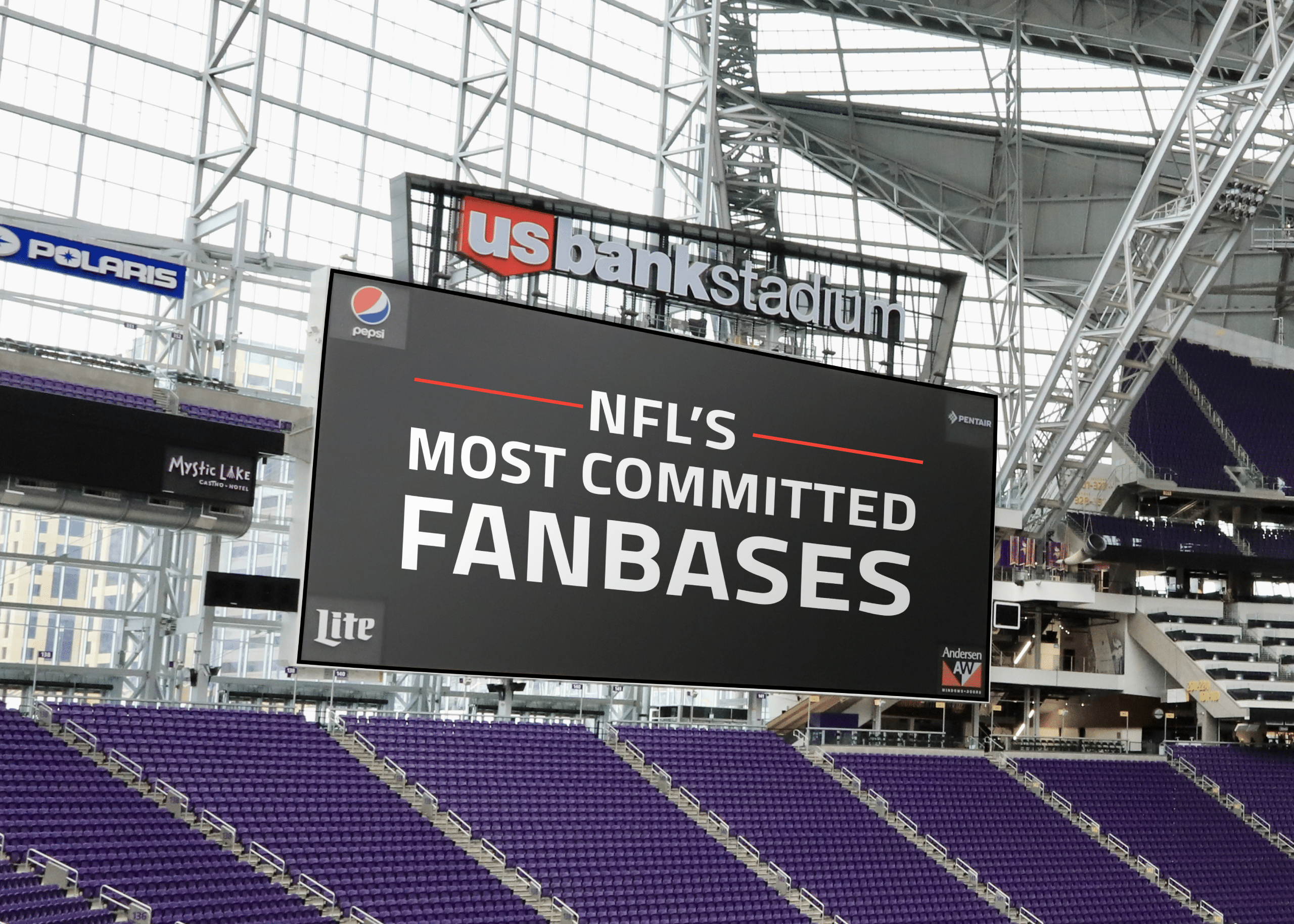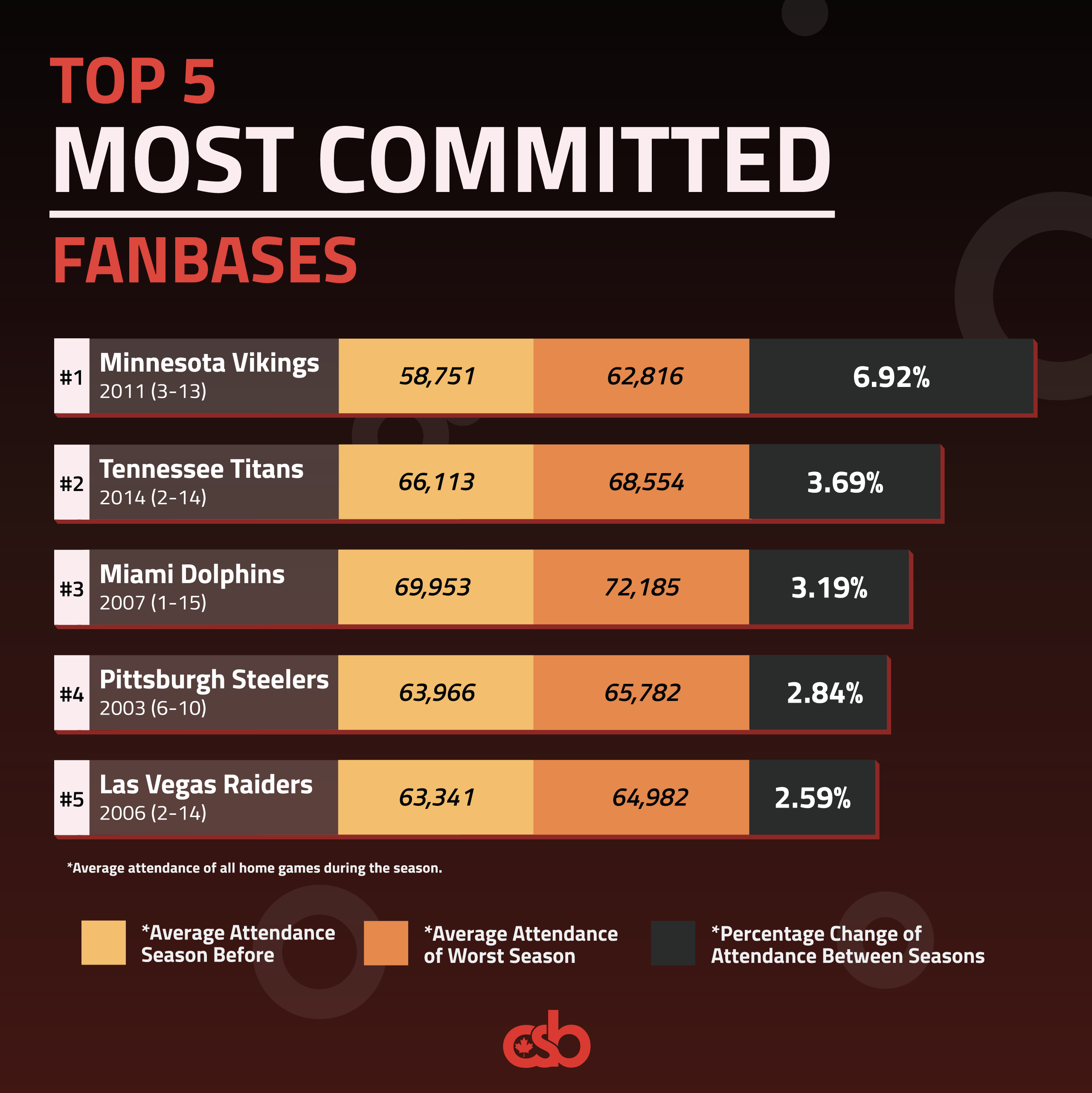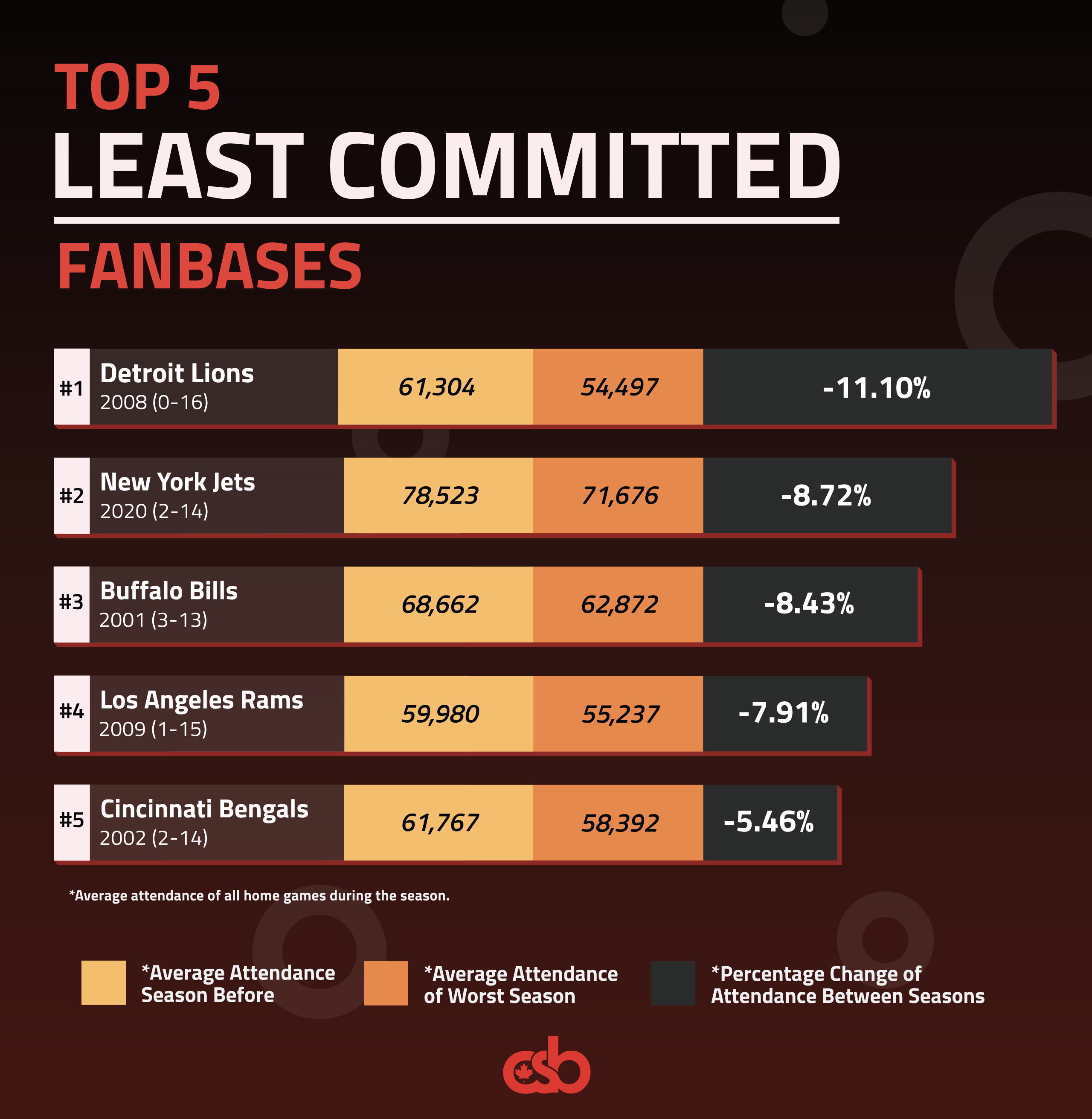
When it comes to loyalty in a sports fan, it isn’t just about celebrating the wins. Attending games even during the toughest seasons shows just how much a fan supports their team, but some fanbases are more committed than others.
Every NFL team has had its forgettable year, or even worse, a season so bad that you can’t help but remember it. However, the key factor here is whether fans stuck around when their team hit rock bottom, as that’s a true sign of dedication.
We wanted to know which NFL teams still drew crowds even when the scoreboard wasn’t in their favor, so we decided to carry out some research. We crunched the numbers and looked at each team’s worst season since 2000, based on record and point differential, then compared attendance data to the previous season.
The result is a fascinating deep-dive into which fanbases turned up no matter what, and which ones quietly ghosted their team when things were looking bleak. If you’re feeling optimistic about your NFL team’s chances to win this year’s Super Bowl, check out the best NFL betting sites here.
Let’s take a look at the most (and least) committed NFL fanbases of the 21st century. Fingers crossed your team made the good list!
The Most Committed NFL Fanbases of the 21st Century
We’ll begin by focusing on the NFL teams whose fans stuck by their side during their worst season since 2000:

1. Minnesota Vikings – 6.92% increase
Back in 2011, the Minnesota Vikings had a truly terrible season. The team struggled due to a combination of inconsistent quarterback play, numerous injuries and a rebuilding roster.
Veteran quarterback Donovan McNabb underperformed early on, leading to a midseason switch to Christian Ponder. And though Ponder did his best, he faced the usual rookie growing pains behind a shaky offensive line. The result was a 3–13 finish, which was their worst record since 1984.
But despite all of these setbacks, the average attendance for the Minnesota Vikings during this season was 62,816, which was actually a 6.92% increase on their previous season average of 58,751.
That there is true fan loyalty!
2. Tennessee Titans – 3.69% increase
The worst season for the Tennessee Titans was 2014, which was when everything unraveled due to instability from the quarterback, poor offensive production, and a porous defense.
Injuries and erratic performance forced the team to cycle through multiple QBs, including Jake Locker, Charlie Whitehurst and rookie Zach Mettenberger, none of whom could spark the offense. And defensively, the Titans struggled to stop the run and allowed over 27 points per game, leading to a 2–14 finish.
However, their average attendance that season was 68,554, which was a 3.69% increase from the previous season’s 66,113.
3. Miami Dolphins – 3.19% increase
The Miami Dolphins’ 2007 season was derailed by a mix of injuries, poor roster depth and quarterback problems. They cycled through multiple QBs when Trent Green suffered a severe concussion in Week 5, resulting in Cleo Lemon and rookie John Beck being forced into action.
The result was a disastrous 1–15 record, their worst in franchise history, with their only win coming in overtime late in the season. But even though 2007 was really rough for the Miami Dolphins, their average attendance increased 3.19% from 69,953 to 72,185.
4. Pittsburgh Steelers – 2.84% increase
If you’re a Pittsburgh Steelers fan, you most likely remember (or have heard about) the 2003 season. It all stemmed from an unbalanced offense, a struggling run game and a wavering defense.
With injuries to key running backs and a declining ground attack, the team relied heavily on quarterback Tommy Maddox, leading to turnovers and missed opportunities. Combined with a defense that couldn’t close out games, the Steelers stumbled to a 6–10 record, their worst under head coach Bill Cowher.
And yet, they too received higher average attendance during this season, jumping from 63,966 to 65,782, which is a 2.84% increase.
5. Las Vegas Raiders – 2.59% increase
In 2006, when they were still in Oakland, the Las Vegas Raiders endured a disastrous season due to one of the league’s worst offenses, fueled by poor QB play and a leaky offensive line.
Quarterbacks Aaron Brooks and Andrew Walter struggled behind constant pressure, leading to just 12 total offensive touchdowns all year. And despite a solid defense, the lack of scoring doomed the team to a 2–14 finish.
But don’t be dismayed, as fans of the Las Vegas Raiders turn up no matter what! Average attendance that year was 64,982, which was 2.59% higher than the previous season’s average of 63,341.
The Least Committed NFL Fanbases of the 21st Century
At the other end of the scale, some NFL teams saw a drop-off in attendance during rocky times:

1. Detroit Lions – 11.10% decrease
The Detroit Lions’ 2008 season was historically bad, ending with an unprecedented 0–16 record, which was the first winless 16-game season in NFL history.
The team struggled in nearly every phase, with poor quarterback play, a weak defense and questionable coaching decisions under Rod Marinelli. Turnovers, blown leads and a lack of depth doomed them from the start, making the season a perfect storm of dysfunction.
Despite an average attendance of 61,304 the previous season, the Detroit Lions had the biggest drop in 2008. Falling by a mighty 11.10%, it levelled out at 54,497.
2. New York Jets – 8.72% decrease
The New York Jets’ 2020 season was marred by a combination of offensive struggles, roster challenges and a lack of cohesive coaching.
Quarterback Sam Darnold faced injuries and unpredictable play, leading to one of the league’s lowest-scoring offenses. Head coach Adam Gase’s leadership came under scrutiny, culminating in his dismissal after the team finished with a 2–14 record, marking their worst performance since 1996.
During the previous season, the New York Jets had an average attendance of 78,523, but in 2021 it fell by 8.72%, resulting in an average of 71,676. Due to limited attendance during the 2020 season caused by COVID-19 restrictions, data from 2021 was used instead.
3. Buffalo Bills – 8.43% decrease
The Buffalo Bills’ 2001 season fell apart due to a combination of a young, unsettled quarterback situation and a struggling offensive line.
Rookie QB Travis Henry showed flashes but was inconsistent, while the team rotated between Rob Johnson and Alex Van Pelt under center. Defensive lapses and a tough AFC East schedule didn’t help, leading to a 3–13 finish and their worst record since 1985.
Buffalo Bills had an average attendance of 68,662 the previous season, falling to 62,872 in 2001, which was a reduction of 8.43%.
4. Los Angeles Rams – 7.91% decrease
In 2009, the St. Louis Rams (before relocating to Los Angeles) had a dismal season due to injuries, a lack of offensive firepower and instability at quarterback.
They cycled through Marc Bulger, Kyle Boller and rookie Keith Null, but managed just one win and scored a league-low 175 points all season. With few playmakers outside of running back Steven Jackson, the Rams finished 1–15, which was the worst record in the NFL that year.
With the previous season seeing an average attendance of 59,980, the Los Angeles Rams experienced a 7.91% decrease to 55,237 during their worst season.
5. Cincinnati Bengals – 5.46% decrease
The Cincinnati Bengals’ 2002 season was plagued by poor quarterback play, defensive breakdowns and a lack of overall cohesion.
The team cycled through QBs, including Jon Kitna and Akili Smith, but couldn’t find consistent production, while the defense gave up the second-most points in the league. Their 2–14 finish led to the firing of head coach Dick LeBeau.
During the previous season, the average attendance of Cincinnati Bengals fans was 61,767, but this dropped 5.46% to 58,392.
Did Your Team’s Fanbase Make the Lists?
This just goes to show that some fanbases are more committed than others, attending a game to cheer on their team regardless of how bad the season is. Did your team make the top 5? If you’re a Minnesota Vikings fan, give yourself a pat on the back!
Methodology
For each NFL team, we identified their worst season from 2000 to the present based on key data, including win-loss record, point differential, and any major context (key injuries, scandals, rebuilding years, etc.).
We then pulled average home game attendance from that season and compared it to the year before, giving us a measure of how committed the fans (and teams) really were during the hardest of times.
Due to restricted attendance during the 2020 season as a result of COVID-19 regulations, data from the 2021 season was utilized in its place to ensure greater accuracy and representativeness.